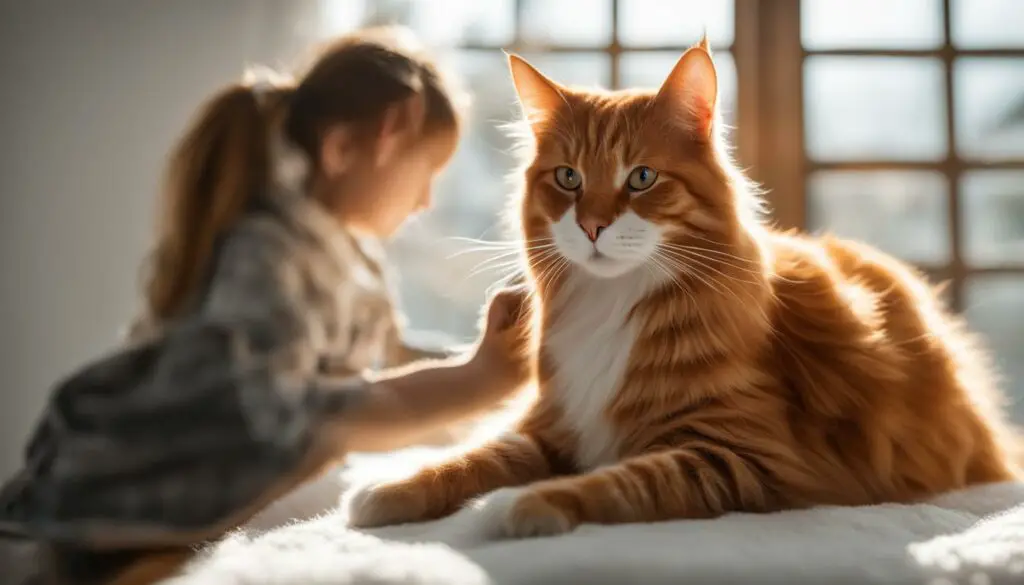Grooming plays a vital role in the overall well-being of our feline friends. One aspect of grooming that many cats truly enjoy is being brushed. Yes, you heard it right! Contrary to popular belief, cats can actually develop a love for the grooming process.
As a cat owner, understanding why your cat loves being brushed is crucial for their care and hygiene. In this comprehensive guide, I will delve into the fascinating world of cat grooming, uncovering the reasons behind their affinity for brushing, providing essential tips for introducing it into their routine, and exploring the numerous benefits it offers.
Key Takeaways:
- Cats can develop a love for being brushed with proper introduction and techniques.
- Understanding your cat’s individual preferences and needs is crucial for a positive grooming experience.
- Regular brushing helps keep your cat clean, healthy, and well-groomed.
- The right grooming tools and techniques are essential for successful brushing sessions.
- Grooming strengthens the bond between you and your cat while promoting their overall well-being.
It All Depends On the Cat
When it comes to cat grooming, whether or not a cat enjoys being brushed depends on its individual personality and past experiences. Just like humans, cats have unique preferences and behaviors that shape their grooming preferences. Some cats may find brushing to be a pleasurable and relaxing experience, while others may be resistant or fearful. It is important to be patient and understanding as you introduce brushing into your cat’s routine, taking into account their individual needs.
Understanding your cat’s grooming preferences can help you tailor the grooming experience to their liking. Some cats may enjoy a gentle brush with soft bristles, while others may prefer a massage-like brushing motion. By observing your cat’s reactions and body language during grooming sessions, you can determine what methods and tools work best for them.
For cats who are apprehensive about being brushed, it is crucial to take a gradual and gentle approach. Start by introducing the brush during bonding and play sessions, allowing your cat to become familiar with the tool without associating it with grooming. Over time, gradually transition to incorporating brushing into these sessions, always keeping a calming and positive demeanor. With patience and consistency, your cat may develop a liking for being groomed and even look forward to their brushing sessions.
Grooming with Care and Understanding
Grooming is an essential part of keeping your cat healthy and happy. While some cats may enjoy being brushed, others may require alternative grooming methods such as grooming gloves or wipes. It is important to respect your cat’s preferences and tailor the grooming routine accordingly. By taking the time to understand your cat’s individual grooming behavior and needs, you can ensure a positive and enjoyable grooming experience for both you and your feline friend.
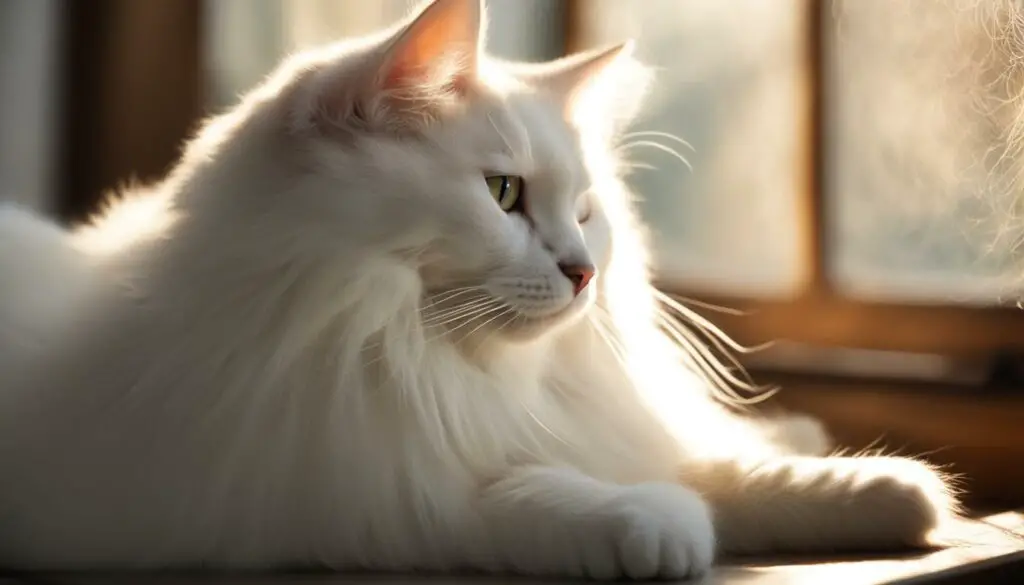
The 3 Common Reasons Why Cats Don’t Like Being Brushed
Many cat owners have experienced the challenge of a resistant feline when it comes to brushing. Understanding the reasons why cats may dislike this grooming activity can help you find solutions to make the experience more pleasant for your furry friend. The three common reasons why cats don’t like being brushed are:
- Using the wrong type of brush: Cats have different coat types, and using the wrong brush can cause discomfort or pain. It’s important to choose a brush that is suitable for your cat’s fur, whether it’s short, long, or curly. Consult with a veterinarian or a professional groomer to determine the best brush for your cat’s specific needs.
- Skin sensitivities or sores: Cats may have sensitive skin or sores that make brushing painful. It’s crucial to examine your cat’s skin for any signs of irritation or discomfort before brushing. If you notice any redness, swelling, or sores, consult with a veterinarian for appropriate treatment and guidance on how to proceed with grooming.
- Negative past experiences: Cats have long memories, and if they’ve had a previous negative experience with brushing, they may develop a fear or aversion towards it. It could be due to a rough or painful brushing session in the past. To address this, you will need to reintroduce brushing slowly and gently, using positive reinforcement techniques to create a new positive association with the activity.
By addressing these common reasons for resistance, you can tailor your approach to meet your cat’s individual needs and make brushing a more enjoyable and stress-free experience for both of you.
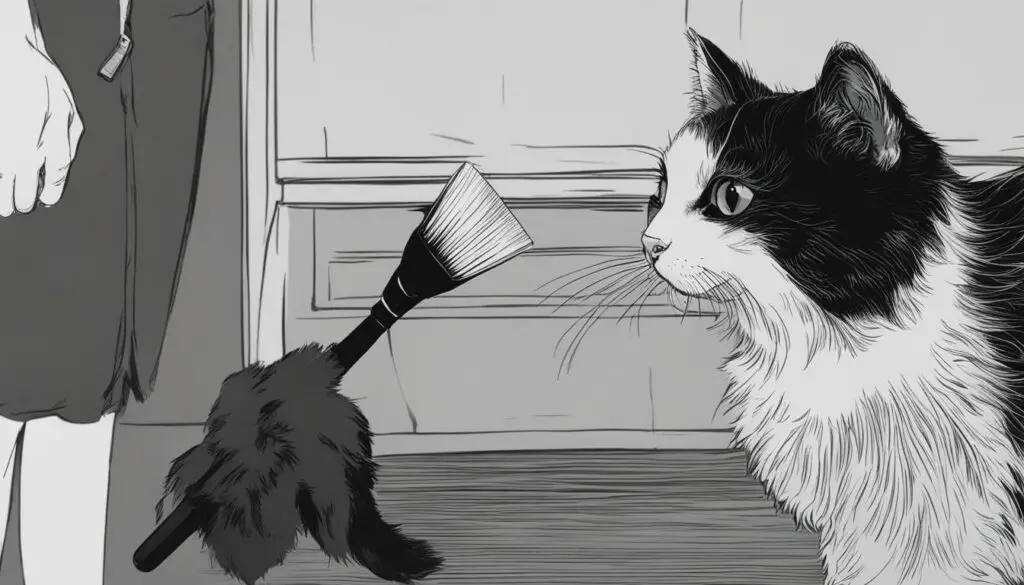
Here’s a table summarizing the common reasons why cats don’t like being brushed:
| Reasons | Description |
|---|---|
| Using the wrong type of brush | Choosing a brush that is not suitable for your cat’s coat type can cause discomfort or pain during brushing. |
| Skin sensitivities or sores | Cats with sensitive skin or sores may find brushing painful. It’s important to check for any signs of irritation or discomfort before brushing. |
| Negative past experiences | Cats may have had a previous bad experience with brushing, leading to fear or aversion. Slow reintroduction and positive reinforcement can help overcome this. |
How To Introduce Brushing To Your Cat’s Routine in 3 Steps
Introducing brushing to your cat’s routine requires a gentle and gradual approach. By following these three steps, you can help your cat become more comfortable with being brushed and create a positive experience for both of you.
Step 1: Select the Right Brush
Choosing the right brush for your cat’s coat type and sensitivities is essential. There are various types of brushes available, such as slicker brushes, bristle brushes, and grooming gloves. Take into consideration the length and texture of your cat’s fur to determine the most suitable brush. If you’re unsure, consult with a veterinarian or a professional groomer for recommendations.
Step 2: Familiarize Your Cat with the Brush
Before you start brushing, allow your cat to become familiar with the brush. Place the brush near your cat’s usual resting area so they can see and smell it. Let them approach the brush at their own pace, without any pressure. This will help create a positive association with the brush and reduce any anxiety or fear.
Step 3: Gradually Introduce Brushing
Once your cat is comfortable with the presence of the brush, start by incorporating it into your regular petting sessions. Begin by gently stroking your cat with the brush, following the natural direction of their fur. Keep the brushing sessions short initially, gradually increasing the duration as your cat becomes more relaxed and accustomed to the sensation. Remember to be patient and provide positive reinforcement, such as treats or verbal praise, to reward your cat for their cooperation.
By taking a gentle and gradual approach to introducing brushing, you can help your cat develop a positive association with grooming and make it a pleasant experience for both of you.

| Benefits of a Gentle Approach | Benefits of a Gradual Process |
|---|---|
| Reduced stress and anxiety for your cat | Allows your cat to adjust at their own pace |
| Promotes a positive association with grooming | Builds trust between you and your cat |
| Minimizes the risk of injury or discomfort | Increases the likelihood of a cooperative cat |
The 3 Tips for Brushing Your Cat
When it comes to brushing your cat, there are a few tips and techniques that can help make the experience more enjoyable for both you and your furry friend. Here are three tips to keep in mind:
- Establish a regular routine: Consistency is key when it comes to brushing your cat. Set aside dedicated time each day or week to groom your cat, depending on their individual needs and coat type. By establishing a regular routine, your cat will become more accustomed to the process and may even begin to look forward to it.
- Go slowly and be gentle: Cats can be sensitive to touch, so it’s important to go slowly and be gentle when brushing. Start with soft strokes and gradually increase the pressure as your cat becomes more comfortable. If your cat shows signs of discomfort or agitation, take a break and try again later.
- Use effective brushing techniques: Different cats have different coat types, so it’s important to use the right brushing techniques for your cat’s specific needs. For cats with short hair, a soft bristle brush or grooming glove can help remove loose fur and keep their coat looking sleek. For cats with long hair, a comb or slicker brush can help prevent mats and tangles. Consult with your veterinarian or a professional groomer for guidance on the best tools and techniques for your cat.
Remember, brushing your cat is not only important for their physical health and hygiene, but it can also be a bonding experience between you and your feline companion. Take your time, be patient, and always monitor your cat’s comfort level during grooming sessions. With these tips in mind, you can create a positive and enjoyable grooming routine for both you and your cat.
Table: Common Cat Brushing Tools and Their Benefits
| Brush Type | Benefits |
|---|---|
| Bristle Brush | Effective for removing loose fur and debris from short-haired cats |
| Slicker Brush | Helps to detangle and remove mats from long-haired cats |
| Grooming Glove | Gentle option for removing loose fur and providing a soothing massage |
| Comb | Useful for removing tangles and preventing matting in long-haired cats |
Each cat is unique, so it may take some trial and error to find the right grooming tools and techniques that work best for your furry friend. The most important thing is to approach brushing with patience, care, and a positive attitude. Happy grooming!
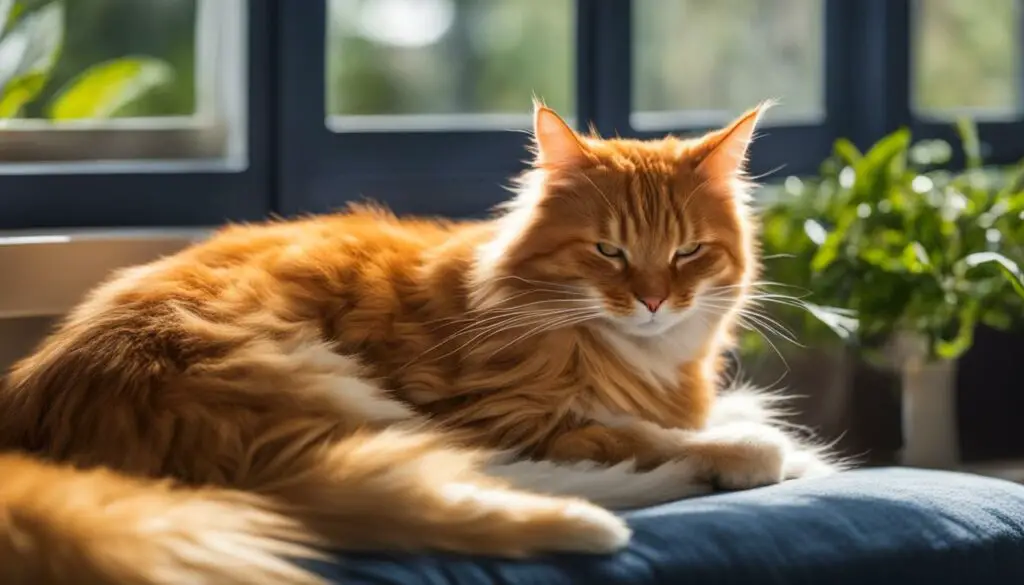
Importance of Grooming
Grooming is an essential aspect of cat care that should not be overlooked. Regular grooming sessions provide numerous benefits for your feline friend, keeping them clean, healthy, and happy. Not only does grooming help remove dirt and loose fur, but it also stimulates healthy oil production in the skin, resulting in a shiny and well-maintained coat.
Moreover, grooming sessions offer a valuable opportunity to detect any potential skin infections, parasites, lumps, or bumps early on. By closely examining your cat’s skin and coat, you can identify any abnormalities and seek timely veterinary care if needed. This proactive approach can help prevent the development and progression of certain health issues.
Regular grooming also plays a significant role in strengthening the bond between you and your cat. The grooming process involves physical contact, which can be incredibly soothing and comforting for your furry companion. It provides a chance for both of you to relax, unwind, and enjoy each other’s company.
Additionally, grooming sessions serve as a form of mental and emotional stimulation for your cat. The act of being groomed can be highly pleasurable and relaxing, promoting a sense of well-being. It can also help alleviate stress and anxiety, making your cat feel secure and loved in their environment.

| Benefits of Grooming: | Pet Bonding: |
|---|---|
| Removes dirt and loose fur | Strengthens the bond between you and your cat |
| Stimulates healthy oil production | Provides an opportunity for relaxation and companionship |
| Promotes a shiny and well-maintained coat | Offers mental and emotional stimulation |
| Detects potential skin infections and issues early on | Alleviates stress and anxiety |
Grooming is not only about maintaining your cat’s physical appearance but also about promoting their overall well-being. The benefits of regular grooming extend beyond mere aesthetics, positively impacting both their physical and emotional health. By making grooming a part of your cat’s routine, you are investing in their happiness and ensuring a strong and loving bond between you and your furry companion.
Grooming Equipment: What Will You Need?
When it comes to grooming your cat, having the right tools can make all the difference. Here are some essential grooming supplies that you will need:
- A cat brush: Choose a brush that is appropriate for your cat’s coat type. For short-haired cats, a bristle brush or grooming glove may work well. Long-haired cats may benefit from a slicker brush or a comb to help detangle their fur.
- Nail clippers or a nail trimmer: Regular nail care is important to keep your cat’s nails at a manageable length. Look for cat-specific nail clippers or a trimmer that is sharp and easy to handle.
- An ear cleaning solution: Keeping your cat’s ears clean is essential for their overall health. Look for a veterinarian-approved ear cleaning solution that is gentle and safe to use.
- A cat-specific toothbrush and toothpaste: Dental care is important to prevent dental disease in your cat. Look for a toothbrush and toothpaste specifically designed for cats.
When choosing grooming tools, it’s important to consider your cat’s individual needs and preferences. Some cats may be more sensitive to certain brushes or tools, so it’s important to test them out and see what works best for your cat. You can try different brushes or tools to find the ones that your cat is most comfortable with.
Choosing the Right Brush
When selecting a brush for your cat, consider their coat type. For short-haired cats, a bristle brush or a grooming glove can help remove loose fur and keep their coat looking shiny. For long-haired cats, a slicker brush or a comb with wide teeth can help detangle their fur and prevent matting.
It’s important to choose a brush that is gentle on your cat’s skin and won’t cause any discomfort. You can test the brush on your own skin to ensure it is not too harsh or abrasive.
| Grooming Equipment | Best for |
|---|---|
| Bristle brush | Short-haired cats |
| Grooming glove | Short-haired cats |
| Slicker brush | Long-haired cats |
| Comb with wide teeth | Long-haired cats |
Remember to groom your cat in a calm and comfortable environment, and always reward them with treats and praise for their cooperation. With the right tools and techniques, grooming can be a positive and bonding experience for both you and your cat.
How to Train Your Cat to Enjoy Being Brushed
Training your cat to enjoy being brushed is a gradual process that requires patience, positive reinforcement, and a gentle approach. By following these steps, you can help your cat develop a positive association with brushing and make it an enjoyable experience for both of you.
Step 1: Start with a calm and relaxed environment
Choose a quiet and comfortable area where your cat feels safe and relaxed. Make sure you have all the necessary grooming tools within reach.
Step 2: Introduce the brush slowly
Start by allowing your cat to sniff and investigate the brush. Let them get familiar with its texture and scent. You can even use treats or catnip to create a positive association with the brush.
“Introduce the brush gradually, using gentle strokes on their face and head. Follow the natural direction of their fur and observe their body language to ensure they are comfortable.”
Step 3: Use positive reinforcement
During the grooming session, reward your cat with treats, verbal praise, and gentle stroking. Keep the sessions short at first and gradually increase the duration over time. Be sure to pay attention to your cat’s response and stop if they show signs of stress or discomfort.
By taking a patient and gentle approach, using positive reinforcement, and allowing your cat to become comfortable at their own pace, you can successfully train them to enjoy being brushed. Remember to always respect your cat’s boundaries and make the experience as positive and stress-free as possible.
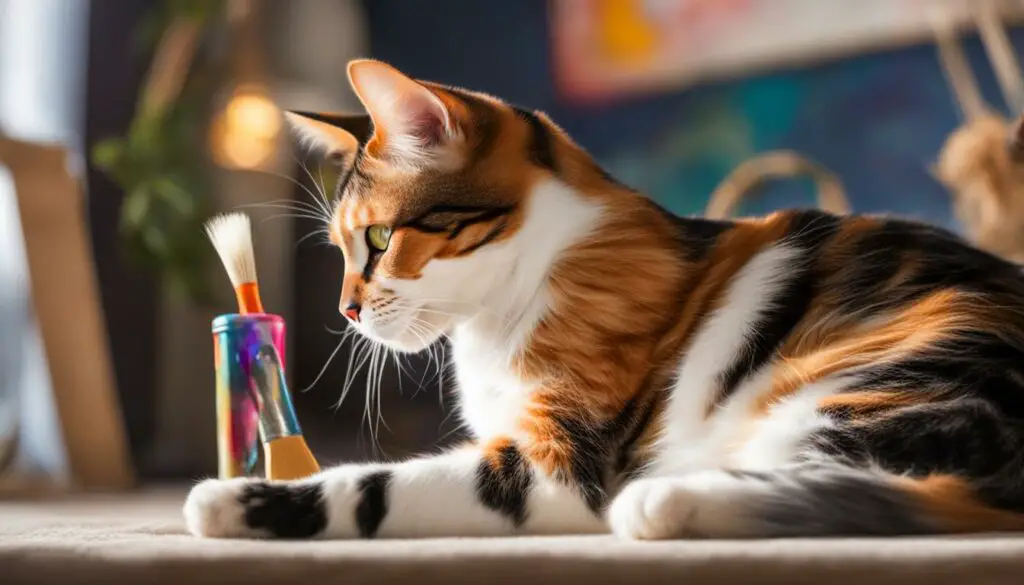
| Benefits of Training Your Cat to Enjoy Being Brushed |
|---|
| 1. Improved coat health and appearance |
| 2. Reduced hairballs and shedding |
| 3. Strengthened bond between you and your cat |
| 4. Early detection of skin issues or parasites |
| 5. Decreased grooming-related anxiety or stress |
Bathing
Cat bathing is an essential part of their grooming routine. While most cats are not fans of getting wet, occasional baths may be necessary to keep them clean and remove dirt or allergens from their fur. It’s important to follow some guidelines to ensure a safe and stress-free bathing experience for both you and your cat.
When bathing your cat, use warm water and a gentle cat shampoo. Be careful to avoid getting water or shampoo in their eyes and ears. Start by wetting your cat’s fur thoroughly, and then apply a small amount of shampoo, working it into a lather. Gently massage the shampoo into their coat, paying attention to areas that may be more prone to dirt or odors, such as the belly or under the tail.
After shampooing, thoroughly rinse your cat’s fur to remove all traces of shampoo. Leaving shampoo residue on their fur can cause skin irritation. Use clean, warm water and ensure that you rinse all areas of their body, including the hard-to-reach spots. Finally, dry your cat off with a warm, clean towel, being careful not to rub too vigorously.
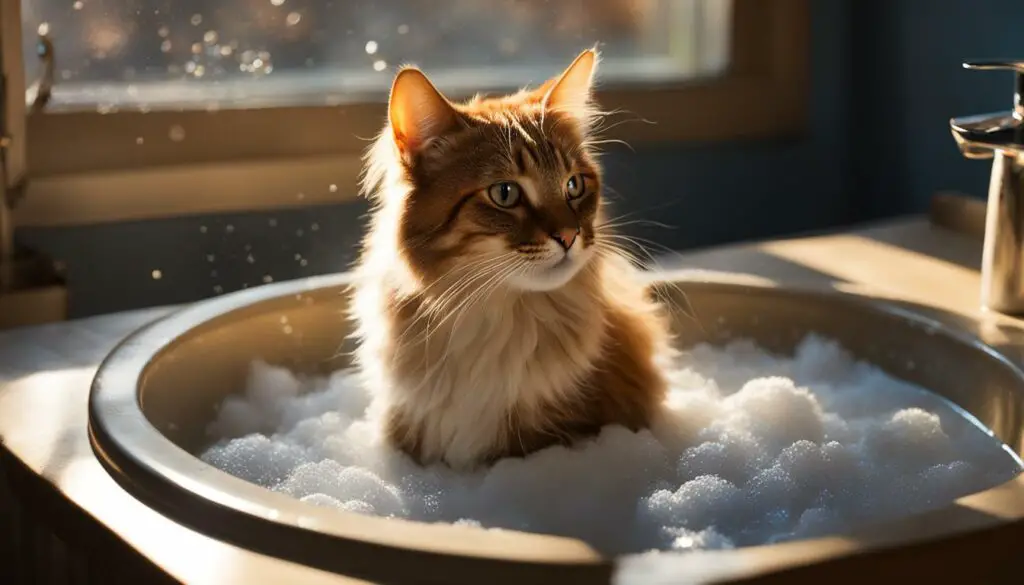
Creating a soothing environment can help make the bathing experience more pleasant for your cat. Choose a quiet and calm area for the bath, away from any distractions or loud noises. It may also be helpful to use a non-slip mat in the tub or sink to provide stability for your cat.
Remember, bathing should only be done when necessary, as cats are generally good at grooming themselves. If your cat has specific skin conditions or you are unsure about bathing them, it’s best to consult with your veterinarian for guidance and advice tailored to your cat’s individual needs.
Cat Nail Clipping: Essential Tips and Tools for Proper Nail Care
Keeping your cat’s nails trimmed is an important part of their grooming routine. Not only does regular nail clipping prevent discomfort and potential injury to both you and your cat, but it also helps to protect your furniture and other household items from scratching. With the right tools and techniques, you can safely and effectively trim your cat’s nails at home.
Tips for Successful Nail Clipping
- Choose the right time: Find a quiet and calm environment where your cat feels relaxed. Consider scheduling nail clipping sessions after your cat has had some exercise or playtime to help them release excess energy.
- Invest in quality nail clippers: Use cat-specific nail clippers that are sharp and designed for safe and precise trimming. Avoid using human nail clippers or scissors, as they can be uncomfortable for your cat and may cause injury.
- Take it slow: Introduce nail clipping gradually and be patient with your cat. Start by gently touching and massaging their paws to get them used to the sensation. Reward your cat with treats and praise throughout the process to create positive associations.
- Know the anatomy: Familiarize yourself with the structure of your cat’s nails. Avoid cutting too close to the pink area, known as the quick, as it is sensitive and may cause bleeding. If you are unsure, consult with your veterinarian or a professional groomer for guidance.
- Trim one nail at a time: Begin by gently extending your cat’s claw and making small, gradual cuts. If your cat becomes stressed or agitated, take a break and try again later. It’s better to trim a few nails at a time than to force your cat through a full trimming session.
Remember, patience and positive reinforcement are key when it comes to nail clipping. If you are uncomfortable performing this task on your own, consider seeking assistance from a professional groomer or your veterinarian. They can provide guidance and demonstrate proper nail trimming techniques to ensure your cat’s nails are kept at a healthy length.
| Tools for Nail Clipping: | Features: |
|---|---|
| Cat-specific nail clippers | Sharp blades for precise cutting |
| Nail file or emery board | To smooth any rough edges after trimming |
| Treats and rewards | To encourage positive behavior and create a pleasant experience |
| Styptic powder | To stop bleeding in case of accidentally cutting the quick |
By incorporating regular nail clipping into your cat’s grooming routine, you can ensure their nails remain at a comfortable length while also minimizing potential damage to your home. Remember to approach nail clipping with patience, gentleness, and positive reinforcement to make it a stress-free experience for both you and your cat.
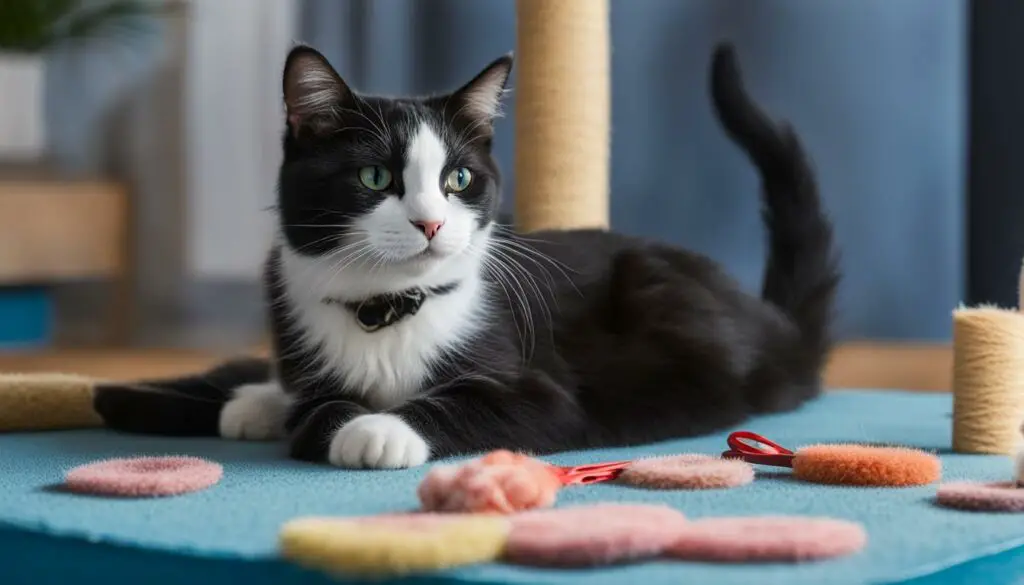
Dental Health
Proper dental care is crucial for maintaining your cat’s overall health and preventing dental diseases. Just like humans, cats can develop dental issues such as gum disease, tooth decay, and tartar buildup. Regular tooth brushing and dental check-ups are essential to ensure your cat’s teeth and gums stay healthy.
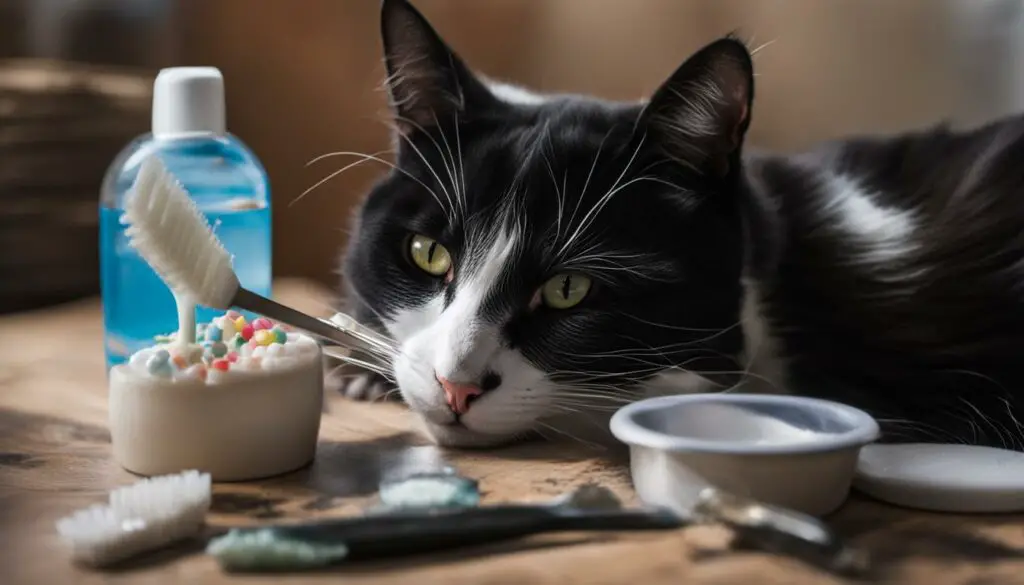
Tooth Brushing
One of the most effective ways to care for your cat’s dental health is through regular tooth brushing. Use a cat-specific toothbrush and toothpaste that is formulated for cats, as human toothpaste can be toxic to them. Start by getting your cat used to the taste and smell of the toothpaste by allowing them to lick it off your finger. Gradually introduce the toothbrush by gently rubbing it along their teeth and gums in a circular motion.
It’s important to be patient and consistent when brushing your cat’s teeth. Start with short brushing sessions and gradually increase the duration as your cat becomes more comfortable. Remember to reward your cat with praise and treats after each successful brushing session to reinforce positive behavior.
Dental Disease Prevention
In addition to regular tooth brushing, there are other steps you can take to prevent dental disease in your cat. Providing dental-friendly toys and treats can help reduce plaque and tartar buildup. Look for products that are specifically designed to promote dental health, such as dental chews or treats that help clean your cat’s teeth as they chew.
Regular dental check-ups with your veterinarian are also important for maintaining your cat’s dental health. Your vet can perform a thorough examination of your cat’s teeth and gums, identify any dental issues, and recommend appropriate treatment if necessary. They can also provide guidance on diet, home care, and additional dental care options that may be beneficial for your cat’s specific needs.
Conclusion
By prioritizing your cat’s dental health and implementing a regular dental care routine, you can help prevent dental diseases and ensure your cat maintains a healthy and happy smile. Remember to be patient and gentle when brushing your cat’s teeth, and seek professional advice from your veterinarian for any concerns or questions you may have regarding your cat’s dental care.
Ear Health
Ensuring proper ear care is an essential part of your cat’s grooming routine. Regularly inspecting your cat’s ears for any unusual smell or discharge can help identify potential issues early on. If you notice any abnormalities, it is important to consult your veterinarian for guidance and appropriate treatment.
When it comes to ear cleaning, it is crucial to use a veterinarian-approved ear cleaning solution. Avoid using cotton swabs or any other objects that can potentially damage your cat’s delicate ear canal. Gently apply the cleaning solution onto a clean cotton ball or pad and carefully wipe the visible parts of your cat’s ears. Be cautious not to insert anything into the ear canal, as this can lead to injury or discomfort for your cat.
Preventing ear infections in cats can be achieved through regular cleaning and maintaining good hygiene practices. Additionally, keeping your cat’s living environment clean and free of irritants can help reduce the risk of ear infections. If you suspect your cat has an ear infection or are unsure about ear cleaning, it is always best to consult your veterinarian for proper diagnosis and guidance.
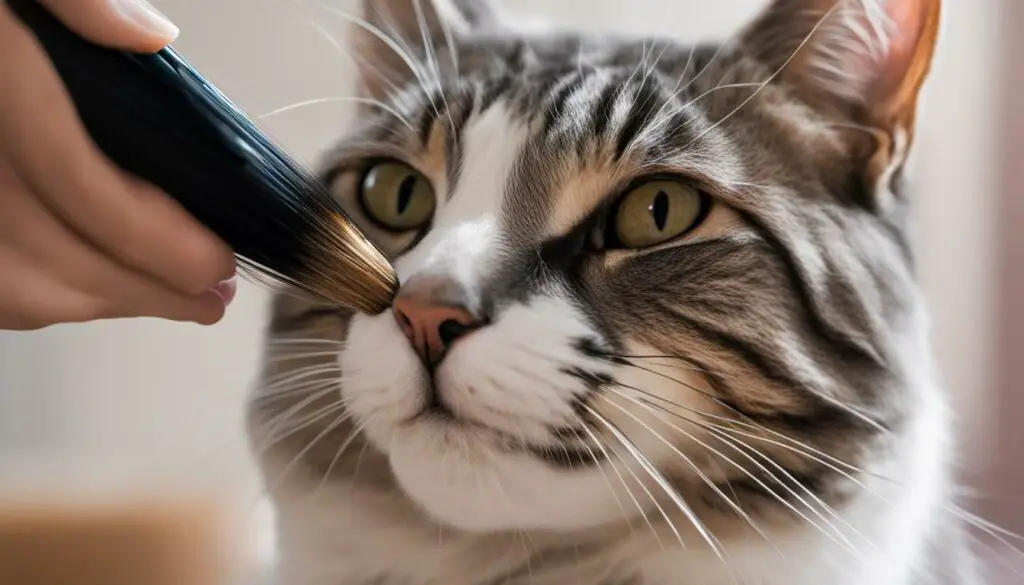
| Signs of Possible Ear Infection: | Ear Cleaning Tips: |
|---|---|
|
|
Conclusion
In conclusion, regular grooming, including brushing, plays a vital role in the overall care and well-being of your cat. Not only does it keep your furry friend clean and healthy, but it also strengthens the bond between the two of you. By understanding your cat’s preferences, selecting the right grooming tools, and gradually training them, you can create a positive and enjoyable brushing experience.
The benefits of brushing go beyond just a clean coat. Brushing helps to remove dirt and loose fur, stimulates healthy oil production in the skin, and promotes a shiny and lustrous coat. It also provides an opportunity to detect any skin infections, parasites, lumps, or bumps early on, ensuring prompt medical attention if needed.
Remember to establish a regular grooming routine, taking into consideration your cat’s specific coat type and grooming needs. Take your time, be patient, and go slowly, especially when introducing brushing to your cat. Always be mindful of their body language and comfort, and never force them into a grooming session. And don’t forget to reward your cat with treats and gentle praise after each successful grooming session.
By incorporating regular grooming into your cat’s care routine, you are not only keeping them healthy and looking their best, but you are also strengthening the special bond that you share. So, grab your grooming tools, create a calm and relaxing environment, and enjoy the benefits of grooming with your feline companion!
FAQ
Do all cats enjoy being brushed?
No, cats have varying preferences when it comes to being brushed. Some love it, while others may find it painful or stressful.
Why do some cats dislike being brushed?
There are a few common reasons. It could be using the wrong type of brush, having skin sensitivities or sores, or negative past experiences with brushing.
How can I introduce brushing to my cat?
The key is to take a slow and gentle approach. Start by selecting the right brush and allow your cat to become familiar with it. Gradually introduce the brush during petting sessions.
What are some tips for brushing my cat?
Establish a regular routine, start slow, and go gently. Be patient and reward your cat after each grooming session. Pay attention to their body language to ensure their comfort.
Why is grooming important for my cat?
Regular grooming helps keep your cat clean, removes dirt and loose fur, promotes a healthy coat, and allows you to detect any skin infections or lumps early on. It also strengthens the bond between you and your cat.
What grooming equipment do I need?
Choose the right tools based on your cat’s coat type and sensitivities. This could include brushes, combs, or grooming gloves. Experiment with different tools to find what works best for your cat.
How can I train my cat to enjoy being brushed?
Start when they are relaxed, use gentle strokes, and let your cat investigate the brush. Reward them with treats, praise, and stroking. Increase the duration of brushing sessions gradually.
Do I need to bathe my cat?
Occasional bathing may be necessary if your cat becomes very dirty. Use warm water and a gentle cat shampoo. Dry them thoroughly afterward.
How do I trim my cat’s nails?
Use a special cat nail trimmer and trim only the tips of the nails. Avoid the blood vessel known as the quick. Provide scratching posts to naturally wear down their nails. Consult a veterinarian if unsure.
How do I take care of my cat’s dental health?
Start daily tooth brushing with a cat-specific toothpaste when they are young. Regular dental check-ups with a veterinarian are important for identifying any dental issues.
How do I clean my cat’s ears?
Regularly inspect the ears for any unusual smell or discharge. Clean as needed using a veterinarian-approved ear cleaning solution. Consult a veterinarian if unsure or if there are signs of infection.

